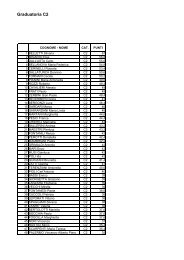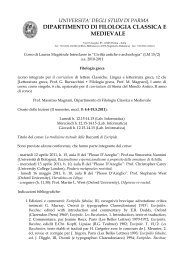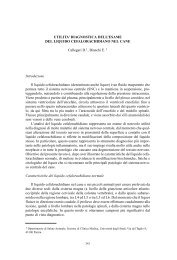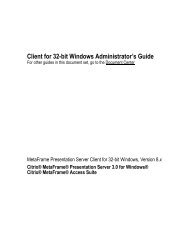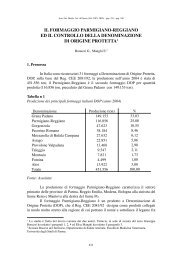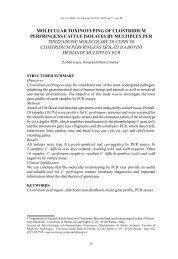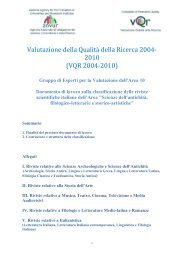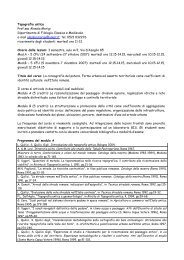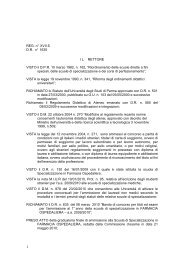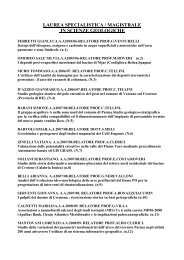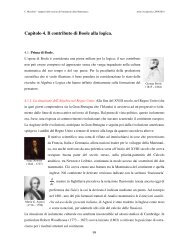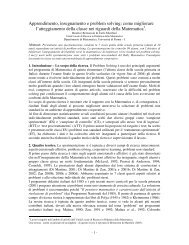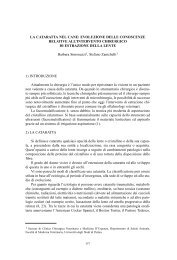Prevalence of Clostridium sPP. in diarrhoeic and healthy dogs ...
Prevalence of Clostridium sPP. in diarrhoeic and healthy dogs ...
Prevalence of Clostridium sPP. in diarrhoeic and healthy dogs ...
Create successful ePaper yourself
Turn your PDF publications into a flip-book with our unique Google optimized e-Paper software.
Ann. Fac. Medic. Vet. di Parma (Vol. XXVII, 2007) pag. 143 - pag. 156by complex qualitative changes from a predom<strong>in</strong>antly aerobic flora <strong>in</strong> the small<strong>in</strong>test<strong>in</strong>e to a predom<strong>in</strong>antly anaerobic flora <strong>in</strong> the large <strong>in</strong>test<strong>in</strong>e. There is a widevariation <strong>in</strong> the bacterial flora between normal <strong>in</strong>dividuals, <strong>and</strong> concentrations maybe affected by a variety <strong>of</strong> circumstances or behaviours, <strong>in</strong>clud<strong>in</strong>g environment, diet,scaveng<strong>in</strong>g <strong>and</strong> coprophagia. Increased numbers <strong>of</strong> bacteria <strong>in</strong> the small <strong>in</strong>test<strong>in</strong>ecarry an <strong>in</strong>creased risk <strong>of</strong> a harmful outcome. Whether this is manifest cl<strong>in</strong>ically willdepend on <strong>in</strong>dividual circumstances, <strong>in</strong>clud<strong>in</strong>g the composition <strong>of</strong> the diet whichbacteria can convert to potentially harmful metabolites. The nature <strong>of</strong> a host responseto the <strong>in</strong>creased load could also be important, <strong>and</strong> this may <strong>in</strong>volve stimulation <strong>of</strong>immunoglobul<strong>in</strong> <strong>and</strong> mucus production, suppression <strong>of</strong> potentially damag<strong>in</strong>g cellmediated immune responses, a compensatory production <strong>of</strong> structural <strong>and</strong> functionalepithelial cell prote<strong>in</strong>s, <strong>and</strong> <strong>in</strong>creased epithelial cell turnover. The threshold betweenapparent normality <strong>and</strong> cl<strong>in</strong>ical disease may therefore differ between <strong>in</strong>dividuals <strong>and</strong>be <strong>in</strong>fluenced by a delicate balance between the micr<strong>of</strong>lora <strong>and</strong> the host. Cl<strong>in</strong>icaldisease associated with bacterial overgrowth is a very common problem <strong>in</strong> <strong>dogs</strong> <strong>and</strong>occurs when this balance is tipped aga<strong>in</strong>st the host [1].Primary enteric bacterial pathogens can also cause acute cl<strong>in</strong>ical diseases<strong>in</strong>ce they possess virulence factors with adverse effect on the <strong>in</strong>test<strong>in</strong>e. Adherenceto the surface or <strong>in</strong>vasion <strong>of</strong> the mucosa facilitate long-term colonization by certa<strong>in</strong>enteropathogens, predispos<strong>in</strong>g to a carrier status or chronic disease, the outcomeprobably depend<strong>in</strong>g on expression <strong>of</strong> virulence determ<strong>in</strong>ants <strong>and</strong> the host response[1].S<strong>in</strong>ce <strong>dogs</strong> are carnivorous, the total length <strong>of</strong> their <strong>in</strong>test<strong>in</strong>e <strong>in</strong> relation to thebody length is somewhat shorter <strong>and</strong> the motility slower than <strong>in</strong> humans. As a wholethe digestive tract <strong>of</strong> dog, however, resembles that <strong>of</strong> humans <strong>and</strong> the physiologyis similar <strong>in</strong> many ways. Like humans, <strong>dogs</strong> utilize <strong>in</strong>test<strong>in</strong>al microbiota <strong>in</strong> theirphysiology <strong>and</strong> both are homothermic mammals. The pH values <strong>in</strong> the differentcompartments <strong>of</strong> the digestive tract are also comparable to those <strong>of</strong> human, be<strong>in</strong>g thepH <strong>in</strong> the dog stomach 3, <strong>in</strong> duodenum <strong>and</strong> jejunum 6, <strong>in</strong> ileum 7.5, <strong>in</strong> colon 6.5 <strong>and</strong><strong>in</strong> feces 6.2 [10].The ma<strong>in</strong> cultivable bacterial groups <strong>and</strong> most common f<strong>in</strong>d<strong>in</strong>gs <strong>in</strong> humans<strong>and</strong> <strong>dogs</strong> are similar, <strong>in</strong>clud<strong>in</strong>g clostridia, bacteroides, streptococci, coliforms,enterococci, lactobacilli <strong>and</strong> veillonellae with <strong>in</strong>creas<strong>in</strong>g counts towards the large<strong>in</strong>test<strong>in</strong>e [10]. Most <strong>in</strong>test<strong>in</strong>al pathogens cause similar cl<strong>in</strong>ical symptoms <strong>in</strong> <strong>dogs</strong> as<strong>in</strong> humans (C. difficile, multiresistant Gram-negatives, enterococci, staphylococci).The most common <strong>in</strong>test<strong>in</strong>al dysfunction <strong>in</strong> <strong>dogs</strong> is diarrhoea. Another commondisturbance, small <strong>in</strong>test<strong>in</strong>al bacterial overgrowth, compos<strong>in</strong>g <strong>of</strong> Escherichia coli,enterococci <strong>and</strong> clostridia is associated with raised serum folate, reduced serumvitam<strong>in</strong> B12 concentrations <strong>and</strong> altered mucosal permeability <strong>and</strong> function [10].In the most cases <strong>of</strong> bacterial overgrowth, the cause cannot be identified, buthost factors known to predispose to bacterial overgrowth <strong>in</strong>clude defective gastric acidsecretion, <strong>in</strong>terference with normal motility or stasis, <strong>and</strong> defective local immunity[1]. Other factors, as a potentially stressful or contam<strong>in</strong>ed environment, diet <strong>and</strong>coprophagia, may also play a role <strong>and</strong> could contribute to the relatively high numbers<strong>of</strong> bacteria reported <strong>in</strong> kennelled <strong>dogs</strong> [1]. The damag<strong>in</strong>g consequences <strong>of</strong> overgrowth145



